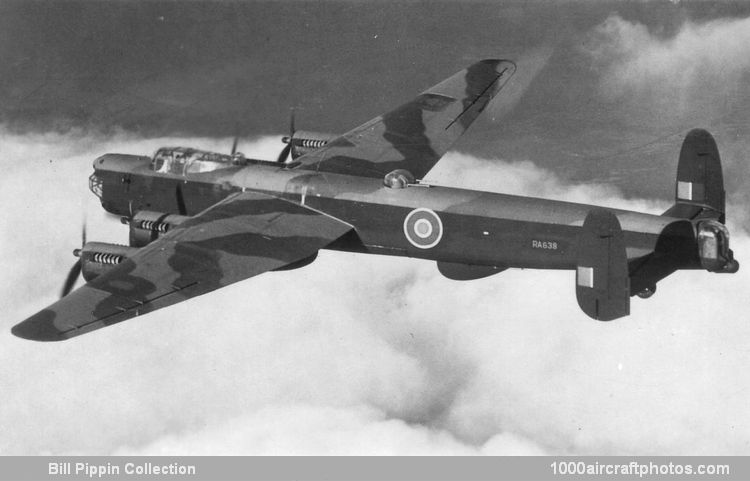12/31/2011. Remarks by Johan Visschedijk: "Ordered by the Air Ministry under Contract No. 2221 from Metropolitan-Vickers Ltd. at Mosley Road, Manchester, this aircraft was produced in early 1945, too late for operational service during WW II. It was one of ten Lincoln B.Mk.Is that were used by the BBU (Bomber Ballistics Unit) at Martlesham Heath, Suffolk.
For trajectory research, inert bombs, conventional as well as dummy nuclear types, were dropped over the Orford Ness Range, just 12.5 mls (20 km) east of Martlesham Heath. They were tracked by instrumentation on the ground and occasionally a bomb had a flare fitted to the tail for better optical tracking.
The standard Lincoln had a ceiling of 23,000 ft (7,010 m), but the BBU Lincolns were modified to reach higher altitudes, and heights of over 40,000 ft (12,192 m) were measured. Crews for these high-altitude flights in the unpressurized Lincoln were selected after checks in the decompression chamber at the RAE at Farnborough, Hampshire.
On November 30, 1951, RA638 was transferred to RAAF Woomera Airfield, Southern Australia, where it was used by the LRWRE (Long Range Weapons Research Establishment)."
Additional information from Rod Farquhar (Lincoln editor at ADF-Serials): "During the late 1940s and early 1950s a number of RAF Lincolns came to Australia, they were B.Mk.Is RA638, RA640, RA644, RE258, RE259, and B.Mk.IIs RE339, RE418, RE423 and RF403. They came under the control of the Weapons Research Establishment which was adjacent to the RAAF Edinburgh Airfield, Adelaide, Southern Australia.
They were operated by No. 1 Air Trials Unit at Woomera and No. 2 Air Trials Unit at Edinburgh, most of the flying was done at Woomera and air and ground crew were usually RAF.
The aircraft were used for a variety of trials but a lot was to do with dropping conventional bombs including the wartime 22,000 lb (9,979 kg) Tallboy from high altitude, the Lincolns B.Mk.IIs were used because they had a higher service ceiling than the Australian built B.Mk.30s.
Two of these B.Mk.IIs, RE339 and RE418, were fitted with Bristol Theseus turboprops on the outboard stations and had eight bladed contra-rotating propellers, in this configuration they could reach 43,000 ft (13,106 m). Another B.Mk.II, RF403, had Armstrong Siddeley Python turboprops fitted in a similar manner.
In March1955 B.Mk.II RF423 was approved for conversion to components but instead was given to the Department of Civil Aviation for use in the testing of a proposed new aircraft rescue/firefighting vehicle at Laverton, Western Australia. The vehicle was not proceeded with and the aircraft was eventually burnt out."
